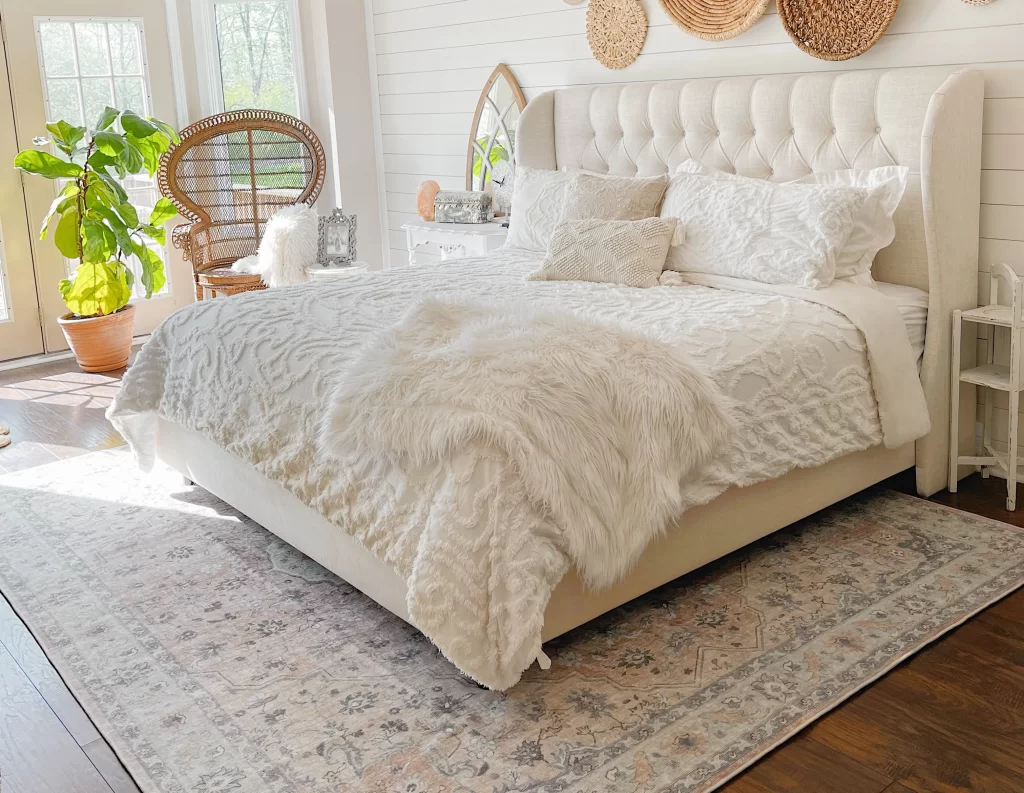What Size Rug For King Size Bed

Choosing the Perfect Rug: What Size for a King Size Bed?
Introduction
The bedroom is a sanctuary, a place of relaxation and rejuvenation. When it comes to bedroom aesthetics, every element plays a crucial role in creating a harmonious and inviting atmosphere. One key element that often takes center stage is the rug. However, finding the perfect rug size, especially for a king-size bed, requires careful consideration. In this comprehensive guide, we’ll explore the intricacies of rug sizing and unveil the secrets to choosing the ideal rug that complements a king-size bed. Additionally, we’ll address common questions to provide you with a holistic understanding of how to enhance your bedroom’s comfort and style.
Understanding Rug Dimensions
Before we dive into the nuances of rug sizing, it’s essential to establish a foundation by understanding the standard dimensions of a king-size bed.
- King Size Bed Dimensions:
- Width: 76 inches
- Length: 80 inches
With these measurements in mind, let’s explore the various rug size options and their impact on the overall aesthetic of your bedroom.
What Size Rug for a King Size Bed?
1. Large Rug Under the Bed
Opting for a large rug that extends well beyond the dimensions of the king-size bed creates a luxurious and cohesive look. This style involves placing the rug underneath the entire bed and accompanying furniture, such as nightstands and dressers. The expansive rug provides a plush surface for your feet when getting in and out of bed, creating a sense of comfort and luxury.
Benefits:
- The large rug anchors the entire bedroom ensemble, creating a unified and visually appealing space.
- It offers a soft and comfortable surface underfoot, adding to the overall coziness of the room.
- The rug provides a frame for the bed and surrounding furniture, enhancing the room’s symmetry.
Considerations:
- Ensure that the rug extends at least 18-24 inches beyond the sides of the bed and 24-36 inches at the foot of the bed for a balanced look.
- Center the rug under the bed to create a symmetrical and aesthetically pleasing arrangement.
2. Runner Rugs on Either Side
Another stylish option is to use runner rugs on either side of the bed. Runner rugs are long, narrow rugs that can add symmetry and warmth to the bedroom while leaving the area underneath the bed exposed. This choice offers a dynamic and visually interesting layout, especially if you want to showcase more of the flooring or if you have hardwood or laminate floors that you want to highlight.
Benefits:
- Runner rugs add a touch of sophistication and style to the bedroom without covering the entire floor.
- They provide a soft surface on either side of the bed, offering comfort and warmth where it’s needed most.
- This layout allows you to showcase more of the bedroom flooring, making it an excellent choice for rooms with visually appealing floors.
Considerations:
- Ensure that the runner rugs are proportionate to the width and length of the bed, extending beyond the bed on both sides.
- Aim for symmetry by placing the runner rugs at an equal distance from the sides of the bed.
3. End-of-Bed Rug
Placing a rug at the foot of the bed, known as an end-of-bed rug, is a popular choice. This creates a focal point and adds a touch of comfort for your feet when getting in and out of bed. The end-of-bed rug is a versatile option that allows you to introduce patterns, colors, or textures without covering the entire bedroom floor.
Benefits:
- The end-of-bed rug serves as a decorative accent, adding visual interest to the foot of the bed.
- It provides a soft landing spot for your feet, especially in the morning or before bedtime.
- This option allows you to experiment with different rug styles, from bold patterns to luxurious textures.
Considerations:
- Choose a rug that complements the overall color scheme and design of the bedroom.
- Ensure that the rug’s size is proportionate to the width of the bed, extending slightly beyond each side.
4. Layered Rugs
For a more eclectic and bohemian look, consider layering rugs. This involves placing a larger rug under the bed and layering a smaller, decorative rug at the foot of the bed. Layering rugs adds texture, dimension, and a touch of whimsy to the bedroom, making it a popular choice for those who enjoy a more relaxed and curated aesthetic.
Benefits:
- Layering rugs allows you to play with different patterns, textures, and colors, creating a personalized and visually dynamic space.
- It offers an opportunity to showcase unique and eye-catching rug designs without overwhelming the entire room.
- The layered look adds warmth and character to the bedroom, making it feel inviting and lived-in.
Considerations:
- Ensure that the larger rug underneath the bed is appropriately sized, extending beyond the bed on all sides.
- Choose a smaller rug for layering that complements the color scheme and design elements of the larger rug.
FAQs: Clarifying Common Queries
1. What is the ideal size for a rug under a king-size bed?
The ideal size for a rug under a king-size bed is typically 9×12 feet or larger. This ensures that the rug adequately extends beyond the bed, creating a balanced and visually pleasing arrangement. The goal is to provide enough coverage on the sides and at the foot of the bed to anchor the entire bedroom ensemble.
2. Should the nightstands be on or off the rug?
Ideally, the nightstands should be on the rug. Placing the nightstands on the rug helps integrate the entire bedroom furniture ensemble and provides a cohesive look. This arrangement creates a sense of unity and symmetry in the room.
3. Can I use a smaller rug for a king-size bed to save money?
While using a smaller rug might be tempting for budget reasons, it can visually imbalance the room. Investing in a properly sized rug enhances the overall aesthetics of the bedroom and contributes to a more cohesive and well-designed space. Consider the rug as an essential element of your bedroom decor, worth the investment for its visual impact and comfort.
4. Should the rug be centered under the bed?
Yes, ideally, the rug should be centered under the bed to create a symmetrical and visually appealing arrangement. Centering the rug ensures a balanced look and provides a sense of proportion in the room. If you opt for a large rug that extends beyond the bed, make sure it is positioned centrally to maintain symmetry.
5. Can I use a round rug with a king-size bed?
Yes, a round rug can work well with a king-size bed, especially if you choose a larger size to accommodate the dimensions of the bed and surrounding furniture. A round rug can add a unique and unexpected element to the room, creating a focal point at the center of the bedroom. Ensure that the round rug is proportionate to the bed and maintains balance in the overall design.
6. What is the purpose of a runner rug on the sides of the bed?
Runner rugs on either side of the bed serve multiple purposes. They add a touch of warmth and comfort, especially if you have hardwood or tile floors. Additionally, runner rugs contribute to the overall design by framing the bed and creating a visually appealing pathway. They also provide a soft surface for your feet when getting in and out of bed, enhancing the overall comfort of the bedroom.
7. How far should the rug extend beyond the bed?
The rug should extend at least 18-24 inches beyond the sides of the bed and 24-36 inches at the foot of the bed for a balanced look. This extension ensures that the rug adequately frames the bed and provides a visually pleasing border around the bedroom furniture. Adjust the dimensions based on your room size and personal preferences, but maintain symmetry for an aesthetically pleasing result.
8. Can I use multiple rugs in the bedroom?
Yes, using multiple rugs in the bedroom is a creative way to add texture, color, and visual interest. Layering rugs, as mentioned earlier, is a popular option. You can place a larger rug under the bed and layer a smaller rug or runners for added dimension. The key is to ensure that the rugs complement each other in terms of design and color, creating a cohesive and harmonious look.
9. What materials are best for bedroom rugs?
The choice of materials for bedroom rugs depends on personal preferences and lifestyle factors. Soft and plush materials like wool or natural fibers are ideal for bedroom rugs as they provide comfort and warmth, especially in areas where you may walk barefoot. Additionally, these materials are durable and can withstand regular use in a bedroom setting. Consider the level of foot traffic in your bedroom when choosing rug materials.
10. Can I use an area rug on carpet in the bedroom?
Yes, you can use an area rug on carpet in the bedroom to enhance the overall design and comfort. Choosing a rug that contrasts with the carpet adds visual interest to the space. Ensure that the rug’s size and design complement the existing carpet and contribute to the desired aesthetic. This approach is particularly useful if you want to introduce different textures or colors into the room without replacing the carpet.
Conclusion
Selecting the right rug size for a king-size bed is a nuanced process that involves a thoughtful consideration of the bed’s dimensions, the layout of the room, and your stylistic preferences. Whether you opt for a large rug under the entire bed, choose runners on either side, place an end-of-bed rug, or experiment with layered rugs, the goal is to create a harmonious and visually appealing space. By understanding the principles of rug sizing and exploring various options, you can transform your bedroom into a cozy retreat where comfort meets style. The rug becomes not just a functional accessory but a key element in the overall design, contributing to the ambiance of your personal haven.



